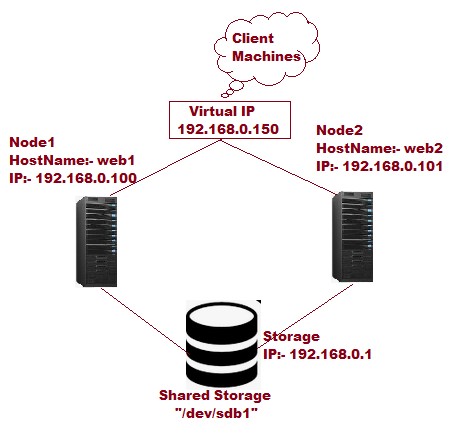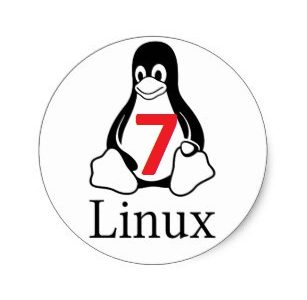Configure High-Avaliablity Cluster on CentOS 7 / RHEL 7

Lab setup:-
Node1:- web1
IP:- 192.168.0.100
Hostname:- web1.feenixdv.com web1
Node2:- web2
IP:- 192.168.0.100
Hostname:- web1.feenixdv.com web1
Cluster Virtual IP:- 192.168.0.150
iSCSI(LUN):- /dev/sdb1
Node basic setup:-
Setup hostname
Check firewall and SELinux (In my lab its enabled)
Yum setup
Setup hostname on both node
[root@localhost ~]# hostnamectl set-hostname web1
Cross entry for each node and also check both node ping to each other with hostname.
[root@web1 ~]# cat /etc/hosts
192.168.0.100 web1.feenixdv.com web1
192.168.0.101 web2.feenixdv.com web2
127.0.0.1 localhost localhost.localdomain localhost4 localhost4.localdomain4
[root@web1 ~]# ping web1
PING web1.feenixdv.com (192.168.0.100) 56(84) bytes of data.
64 bytes from web1.feenixdv.com (192.168.0.100): icmp_seq=1 ttl=64 time=0.038 ms
64 bytes from web1.feenixdv.com (192.168.0.100): icmp_seq=2 ttl=64 time=0.042 ms
^C
— web1.feenixdv.com ping statistics —
2 packets transmitted, 2 received, 0% packet loss, time 999ms
rtt min/avg/max/mdev = 0.038/0.040/0.042/0.002 ms
In cluster setup we need some package with is presend in CD-ROM or ISO. Not in package folder(RHEL7). In “/mnt/addons/HighAvailability/” if CD-ROM mounted on “/mnt”.
We need to copy all the package(Package and HighAvailability) on one node and configure YUM using FTP so both node can install all package.
Going to install “iscsi-initiator-utils” on both node so node and mount shared storage “/dev/sdb1”.
[root@web1 ~]# yum install iscsi-initiator-utils -y
Loaded plugins: langpacks, product-id, search-disabled-repos, subscription-manager
This system is not registered to Red Hat Subscription Management. You can use subscription-manager to register.
Resolving Dependencies
–> Running transaction check
—> Package iscsi-initiator-utils.x86_64 0:6.2.0.873-35.el7 will be installed
–> Processing Dependency: iscsi-initiator-utils-iscsiuio >= 6.2.0.873-35.el7 for package: iscsi-initiator-utils-6.2.0.873-35.el7.x86_64
–> Running transaction check
—> Package iscsi-initiator-utils-iscsiuio.x86_64 0:6.2.0.873-35.el7 will be installed
–> Finished Dependency Resolution
Dependencies Resolved
============================================================================================================================================================================================
Package Arch Version Repository Size
.
.
.
Complete!
[root@web1 ~]#
Now going to discover storage from storage server.
[root@web1 ~]# iscsiadm -m discovery -t st -p 192.168.0.1
192.168.0.1:3260,1 iqn.2018-12.com.feenix:disk1
We found one storage. Put storage details in “initiatorname.iscsi”.
[root@web1 ~]# vim /etc/iscsi/initiatorname.iscsi
[root@web1 ~]# cat /etc/iscsi/initiatorname.iscsi
InitiatorName=iqn.2018-12.com.feenix:disk1
[root@web1 ~]# systemctl enable iscsi
[root@web1 ~]# systemctl restart iscsi
Login into target Storage. Here we can see some issue in login. In this case just restart node and try after reboot.
[root@web1 ~]# iscsiadm -m node -T iqn.2018-12.com.feenix:disk1 -p 192.168.0.1 -l
Logging in to [iface: default, target: iqn.2018-12.com.feenix:disk1, portal: 192.168.0.1,3260] (multiple)
iscsiadm: Could not login to [iface: default, target: iqn.2018-12.com.feenix:disk1, portal: 192.168.0.1,3260].
iscsiadm: initiator reported error (24 – iSCSI login failed due to authorization failure)
iscsiadm: Could not log into all portals
[root@web1 ~]# reboot
[root@web1 ~]# fdisk -l
Disk /dev/sda: 21.5 GB, 21474836480 bytes, 41943040 sectors
Units = sectors of 1 * 512 = 512 bytes
Sector size (logical/physical): 512 bytes / 512 bytes
I/O size (minimum/optimal): 512 bytes / 512 bytes
Disk label type: dos
Disk identifier: 0x00019b5f
Device Boot Start End Blocks Id System
/dev/sda1 * 2048 616447 307200 83 Linux
/dev/sda2 616448 4810751 2097152 82 Linux swap / Solaris
/dev/sda3 4810752 41943039 18566144 83 Linux
Disk /dev/sdb: 2147 MB, 2147483648 bytes, 4194304 sectors
Units = sectors of 1 * 512 = 512 bytes
Sector size (logical/physical): 512 bytes / 512 bytes
I/O size (minimum/optimal): 512 bytes / 4194304 bytes
Disk label type: dos
Disk identifier: 0xd328a924
Device Boot Start End Blocks Id System
/dev/sdb1 8192 4194303 2093056 83 Linux
Here you can see “/dev/sdb1” accessible from node. Something check from other node also.
Through high availability here we are going to configure apache web server so first we need to install apache on both node.
[root@web1 ~]# yum install httpd -y
Update “httpd.conf” with below entry so it can we monitored. Put these entry in bottom of file.
[root@web1 ~]# vim /etc/httpd/conf/httpd.conf
.
.
<Location /server-status>
SetHandler server-status
Order deny,allow
Deny from all
Allow from 127.0.0.1
</Location>
Now mount storage on “/var/www/” and create one example page. Because SELinux enabled in so we need to restore same context for “html folder and index.html”.
After that allow on firewall and reload configuration.
[root@web1 ~]# mount /dev/sdb1 /var/www/
[root@web1 ~]# mkdir /var/www/html
[root@web1 ~]# vim /var/www/html/index.html
[root@web1 ~]# getenforce
Enforcing
[root@web1 ~]# restorecon -R /var/www/
[root@web1 ~]# umount /var/www/
[root@web1 ~]# firewall-cmd –permanent –add-service=http
success
[root@web1 ~]# firewall-cmd –reload
success
Now configure HA cluster. For that we need to install some package.
Also add in firewall.
[root@web1 ~]# yum install pcs fence-agents-all -y
[root@web1 ~]# firewall-cmd –permanent –add-service=high-availability
success
[root@web1 ~]# firewall-cmd –reload
Success
(On both node) To cross verify you can check “hacluster” user present or not.
If present then installation is ok. Otherwise you need to re-check all steps.
Now set password for hacluster user. Make sure password are same on both node.
[root@web1 ~]# cat /etc/passwd |grep hacluster
hacluster:x:189:189:cluster user:/home/hacluster:/sbin/nologin
[root@web1 ~]# passwd hacluster
Changing password for user hacluster.
New password:
BAD PASSWORD: The password is shorter than 8 characters
Retype new password:
passwd: all authentication tokens updated successfully.
Start “pcsd” services and enable it.
[root@web1 ~]# systemctl start pcsd
[root@web1 ~]# systemctl enable pcsd
Created symlink from /etc/systemd/system/multi-user.target.wants/pcsd.service to /usr/lib/systemd/system/pcsd.service.
Authenticate all available node. In my lab setup we have only two node(web1 and web2).
[root@web1 ~]# pcs cluster auth web1 web2
Username: hacluster
Password:
web2: Authorized
web1: Authorized
setup cluster setting on both node(run only one node)
[root@web1 ~]# pcs cluster setup –start –name feenixdv_web web1 web2
Destroying cluster on nodes: web1, web2…
web1: Stopping Cluster (pacemaker)…
web2: Stopping Cluster (pacemaker)…
web1: Successfully destroyed cluster
web2: Successfully destroyed cluster
Sending cluster config files to the nodes…
web1: Succeeded
web2: Succeeded
Starting cluster on nodes: web1, web2…
web2: Starting Cluster…
web1: Starting Cluster…
Synchronizing pcsd certificates on nodes web1, web2…
web2: Success
web1: Success
Restarting pcsd on the nodes in order to reload the certificates…
web2: Success
web1: Success
[root@web1 ~]# pcs cluster enable –all
web1: Cluster Enabled
web2: Cluster Enabled
check status of cluster.
[root@web1 ~]# pcs cluster status
Cluster Status:
Stack: corosync
Current DC: web2 (version 1.1.15-11.el7-e174ec8) – partition with quorum
Last updated: Thu Dec 27 06:48:47 2018 Last change: Thu Dec 27 06:47:46 2018 by hacluster via crmd on web2
2 nodes and 0 resources configured
PCSD Status:
web1: Online
web2: Online
Check pacemaker status.
[root@web1 ~]# pcs status
Cluster name: feenixdv_web
WARNING: no stonith devices and stonith-enabled is not false
Stack: corosync
Current DC: web2 (version 1.1.15-11.el7-e174ec8) – partition with quorum
Last updated: Thu Dec 27 06:49:03 2018 Last change: Thu Dec 27 06:47:46 2018 by hacluster via crmd on web2
2 nodes and 0 resources configured
Online: [ web1 web2 ]
No resources
Daemon Status:
corosync: active/enabled
pacemaker: active/enabled
pcsd: active/enabled
Now we are going to create three resources.
For system file(/dev/sdb1), for cluster VIP, apache config file and status.
All these resources are grouping with apache(–group apache).
[root@web1 ~]# pcs resource create HTTP_Mount_Point filesystem device="/dev/sdb1" directory="/var/www/" fstype="ext4" –group apache
[root@web1 ~]# pcs resource create HTTP_VIP IPaddr2 ip=192.168.0.150 cidr_netmask=24 –group apache
[root@web1 ~]# pcs resource create HTTP_URL apache configfile="/etc/httpd/conf/httpd.conf" statusurl="http://127.0.0.1/server-status" –group apache
Because the node level fencing configuration depends heavily on your environment, we will disable it for this tutorial.
[root@web1 ~]# pcs property set stonith-enabled=false
Note: If you plan to use Pacemaker in a production environment, you should plan a STONITH implementation depending on your environment and keep it enabled.
Now you can see all resources are added and started.
[root@web1 ~]# pcs status
Cluster name: feenixdv_web
Stack: corosync
Current DC: web2 (version 1.1.15-11.el7-e174ec8) – partition with quorum
Last updated: Thu Dec 27 07:04:10 2018 Last change: Thu Dec 27 07:03:58 2018 by root via cibadmin on web1
2 nodes and 3 resources configured
Online: [ web1 web2 ]
Full list of resources:
Resource Group: apache
HTTP_Mount_Point (ocf::heartbeat:Filesystem): Started web1
HTTP_VIP (ocf::heartbeat:IPaddr2): Started web1
HTTP_URL (ocf::heartbeat:apache): Started web1
Daemon Status:
corosync: active/enabled
pacemaker: active/enabled
pcsd: active/enabled
[root@web1 ~]#


